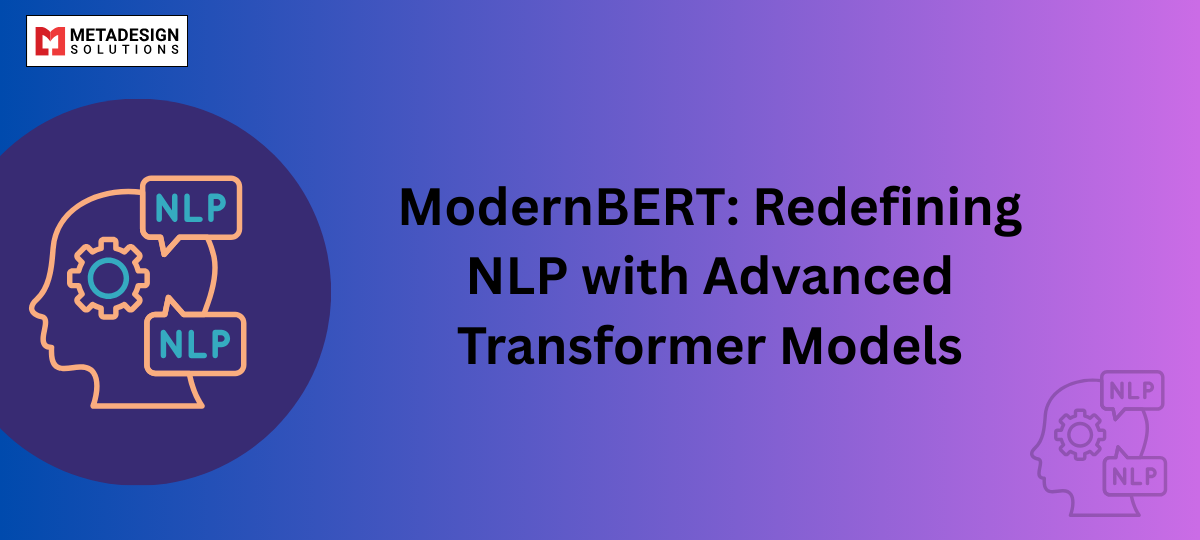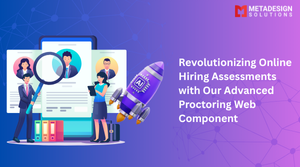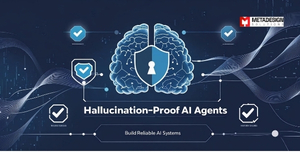What is ModernBERT?
ModernBERT is an advancement in the field of Natural Language Processing (NLP) that builds upon the original BERT (Bidirectional Encoder Representations from Transformers) architecture. As part of LLM/GPT Solutions Development Services, ModernBERT represents a refined evolution, incorporating state-of-the-art techniques to enhance its performance, efficiency, and versatility.
While BERT was groundbreaking, its limitations in scalability, fine-tuning, and adaptability paved the way for ModernBERT. This new iteration not only improves on these aspects but also integrates seamlessly with modern frameworks like LangChain, further extending its utility in building advanced NLP pipelines and AI systems.
Evolution of BERT: From Original to ModernBERT
BERT was introduced by Google AI in 2018 and quickly became the foundation for many NLP models, fundamentally changing how machines understand language. BERT’s core innovation was its bidirectional attention mechanism, allowing it to capture context from both the left and the right of a word, unlike previous models that only considered one direction. However, despite its success, BERT had some limitations that led to the development of ModernBERT.
Some key limitations of BERT that ModernBERT addresses include:
- Training Time and Resource Intensity: BERT required significant computational resources for training, making it less accessible for smaller teams and individuals without access to large-scale infrastructure.
- Fine-tuning Overheads: BERT’s fine-tuning process was complex and required a significant amount of task-specific data to achieve optimal performance.
- Scalability: BERT had difficulty scaling efficiently to very large datasets or handling very long text sequences.
ModernBERT incorporates advancements such as sparsity, pruning, and more efficient use of hardware to overcome these challenges, allowing it to be trained faster and used more easily across a variety of tasks.
Key Features of ModernBERT
ModernBERT offers several key features that enhance its usability and performance compared to the original BERT model:
- Efficiency Improvements: ModernBERT introduces optimizations like model pruning, quantization, and weight sharing, which reduce the overall size of the model and improve inference speed without significantly sacrificing accuracy.
- Scalability: ModernBERT can be scaled more easily to handle larger datasets and longer sequences. This is achieved through techniques like sparse transformers, which allow the model to maintain performance even as the size of the input increases.
- Better Fine-Tuning: ModernBERT incorporates more flexible and efficient fine-tuning mechanisms, making it easier to adapt the model to specific tasks with less data.
- Integration with Other Models: One of the standout features of ModernBERT is its ability to be seamlessly integrated with other machine learning models, allowing for hybrid systems that leverage the strengths of both BERT and other advanced models like GPT and T5.
- Improved Pretraining Tasks: ModernBERT introduces new pretraining tasks beyond masked language modeling and next-sentence prediction, such as contrastive learning, which help the model to better generalize to a wide variety of NLP tasks.
Elevate Your NLP Capabilities with ModernBERT
Harness the power of advanced transformer models for your applications. Schedule a consultation with MDS to integrate ModernBERT into your NLP solutions.
Applications of ModernBERT
ModernBERT is highly versatile and can be applied to a wide range of NLP tasks. Some of the most common applications include:
- Text Classification: ModernBERT excels at understanding the context of text, making it ideal for tasks like sentiment analysis, spam detection, and topic classification.
- Named Entity Recognition (NER): By understanding the relationships between words, ModernBERT is well-suited for identifying and classifying named entities such as people, organizations, and locations.
- Question Answering: One of the most popular applications of BERT models, including ModernBERT, is in question-answering systems where the model extracts answers to user queries from a given text.
- Text Summarization: ModernBERT can be employed for both abstractive and extractive text summarization, condensing long documents into concise summaries.
- Machine Translation: With its ability to understand the context of words and sentences, ModernBERT can be used for high-quality language translation.
- Text Generation: ModernBERT can also be used in generative applications, such as creative writing, content creation, and code generation, by leveraging its transformer-based architecture.
How ModernBERT Works: Architecture and Mechanisms
ModernBERT builds upon the transformer architecture, specifically the encoder part, to process input text. The transformer model uses self-attention to allow the model to consider all words in a sentence simultaneously, rather than sequentially, which enhances its ability to capture long-range dependencies.
The architecture of ModernBERT can be broken down into the following components:
- Input Embeddings: ModernBERT takes input text in the form of tokenized words and converts them into embeddings that represent their semantic meaning in a high-dimensional space.
- Positional Encoding: Since the transformer model doesn’t inherently understand the order of words, positional encoding is added to give the model information about the position of each word in the sequence.
- Self-Attention: This mechanism allows ModernBERT to weigh the importance of different words in a sentence relative to each other, capturing the contextual relationships between them.
- Feedforward Networks: After the self-attention mechanism, a feedforward neural network processes the output to further refine the representations.
- Stacked Layers: ModernBERT stacks multiple transformer layers, each composed of self-attention and feedforward networks, to gradually build up a more sophisticated understanding of the input text.
- Output Layer: Finally, the output of the last transformer layer is passed through a final output layer, which generates predictions for specific tasks, such as token classification, sequence labeling, or text generation.
Training ModernBERT: Data and Techniques
To train ModernBERT effectively, it requires large and diverse datasets, as well as specialized techniques to optimize the learning process. Some of the key techniques used to train ModernBERT include:
- Pretraining on Large Corpora: Like the original BERT, ModernBERT is pretrained on large text corpora using unsupervised learning techniques like masked language modeling (MLM). This helps the model learn the structure and semantics of language.
- Contrastive Learning: ModernBERT often incorporates contrastive learning techniques, where it learns to differentiate between similar and dissimilar pairs of text. This helps improve its ability to generalize across different tasks.
- Multi-Task Learning: ModernBERT can be trained on multiple tasks simultaneously, allowing it to learn shared representations that are useful for a range of applications.
Fine-tuning ModernBERT for Specific Tasks
Fine-tuning is a crucial step in adapting a pretrained model like ModernBERT to perform specific tasks. Unlike the pretraining phase, where the model learns general language patterns, fine-tuning focuses on optimizing the model for a particular application, such as sentiment analysis, named entity recognition, or machine translation.
- Task-Specific Data: Fine-tuning requires labeled data specific to the task at hand. For example, for sentiment analysis, you would fine-tune ModernBERT using a labeled dataset with positive and negative sentiment labels for each text sample.
- Learning Rate and Optimizer: During fine-tuning, the learning rate is often lower than during pretraining to avoid overfitting. Additionally, optimizers like Adam or AdamW (which is a variant of Adam) are commonly used to adjust the model parameters efficiently.
- Early Stopping: To prevent overfitting during fine-tuning, early stopping can be employed, where training is halted once the model’s performance on a validation set stops improving.
- Transfer Learning: One of the strengths of ModernBERT is its ability to transfer knowledge gained during pretraining to a wide variety of tasks. This allows for efficient fine-tuning, even with relatively small datasets.
Fine-tuning ModernBERT can be done using popular deep learning frameworks like TensorFlow, PyTorch, or Hugging Face’s Transformers library, which provides pre-built models and training pipelines for ease of use.
Performance Comparison: ModernBERT vs Other Models
When compared to other NLP models, ModernBERT typically outperforms older models like LSTM (Long Short-Term Memory) and GRU (Gated Recurrent Units) in tasks requiring contextual understanding. However, even within the transformer family, models like GPT (Generative Pretrained Transformer) and T5 (Text-to-Text Transfer Transformer) are often used as alternatives, and each has its strengths and weaknesses in different areas.
- BERT vs ModernBERT: While both BERT and ModernBERT are transformer-based models, ModernBERT includes optimizations for efficiency and scalability. It handles longer sequences better, and its fine-tuning process is more flexible.
- GPT vs ModernBERT: GPT is a decoder-only model, which means it is designed primarily for text generation tasks. In contrast, ModernBERT is an encoder-only model, making it more suited for tasks like classification and question answering. However, ModernBERT can be adapted for text generation tasks with some modifications.
- T5 vs ModernBERT: T5 is a versatile model that frames all NLP tasks as text-to-text problems, making it highly flexible. ModernBERT, on the other hand, is optimized for tasks that require bidirectional understanding of context, so it excels in tasks like sentence completion, question answering, and text classification.
- Performance Benchmarks: ModernBERT has shown strong performance in various NLP benchmarks like GLUE, SQuAD, and SuperGLUE, often outperforming other models due to its efficient design and fine-tuning capabilities.
Challenges and Limitations of ModernBERT
Despite its many advancements, ModernBERT still faces several challenges and limitations:
- Resource Intensity: Training and deploying ModernBERT can still be resource-intensive, especially when working with very large datasets or long input sequences. Although optimizations have been made, it still requires significant computational power, particularly for fine-tuning on large tasks.
- Biases in the Model: Like all large language models, ModernBERT is prone to inheriting biases present in the data it is trained on. This can lead to undesirable outputs, such as biased sentiment analysis results or inappropriate language generation.
- Interpretability: Despite its impressive performance, ModernBERT, like most deep learning models, remains a “black box” in terms of interpretability. Understanding why the model makes a particular decision or prediction can be challenging, which is crucial in some high-stakes applications like healthcare or finance.
- Context Length Limitations: Although ModernBERT addresses the issue of long sequences better than its predecessors, it still faces limitations when dealing with very long texts. Techniques like sparse transformers can alleviate this to some extent, but there is still room for improvement in handling ultra-long documents.
Future of ModernBERT and Transformer Models
The future of ModernBERT and other transformer-based models looks promising, with several advancements on the horizon:
- Efficient Transformers: As the demand for larger and more efficient models grows, the focus will likely shift towards improving the efficiency of transformers through techniques like pruning, distillation, and hardware-specific optimization.
- Multimodal Models: The future of NLP models like ModernBERT may involve integrating other modalities of data, such as images or audio. By combining textual understanding with visual or auditory information, transformers could open up new frontiers in applications like autonomous systems, healthcare, and robotics.
- Zero-Shot and Few-Shot Learning: Transformer models are expected to get better at zero-shot and few-shot learning, where the model can perform tasks with little to no task-specific training data. This would make it easier to deploy ModernBERT in scenarios where labeled data is scarce or unavailable.
- Responsible AI: There is increasing attention on making AI models more transparent, fair, and ethical. Future versions of ModernBERT may incorporate mechanisms to reduce biases, improve interpretability, and ensure that the model’s decision-making process is more understandable and justifiable.
Learning Resources
- Books:
- Transformers for Natural Language Processing by Denis Rothman
- Deep Learning with Python by François Chollet (for foundational understanding of deep learning)
- Online Courses:
- Natural Language Processing with Transformers on Coursera
- Deep Learning Specialization on Coursera (includes a section on NLP)
- Research Papers:
- BERT: Pre-training of Deep Bidirectional Transformers for Language Understanding by Jacob Devlin et al. (introduces BERT)
- ModernBERT: Advancements in Transformer Models (research papers detailing the improvements in ModernBERT)
- Tools and Libraries:
- Hugging Face Transformers: A Python library that simplifies the use of transformer models for various NLP tasks.
TensorFlow and PyTorch: Deep learning frameworks that allow you to train and fine-tune transformer models, including ModernBERT.
Conclusion
ModernBERT represents a significant step forward in the evolution of transformer-based models, offering improvements in efficiency, scalability, and versatility over its predecessor, BERT. By incorporating optimizations and advanced techniques like contrastive learning and multi-task learning, ModernBERT has become a powerful tool for a wide range of NLP tasks. While it still faces challenges such as resource intensity and bias, its potential for future advancements makes it an exciting model to watch in the world of AI development and NLP.
As the demand for more powerful and efficient language models continues to grow, ModernBERT is likely to play a central role in shaping the future of artificial intelligence, making it an essential component of any NLP-focused application or research project.
Related Keyphrase:
#ModernBERT #NLP #TransformerModels #AI #MachineLearning #NaturalLanguageProcessing #DeepLearning #AdvancedAI #LanguageModels #BERT #AIInnovation #TextProcessing #DataScience #AIApplications #TechInsights #NLPTools #AIResearch #TextAnalytics #AIEngineering #ArtificialIntelligence #AIModels #LLM #LargeLanguageModels #BERTNLP #TransformerAI #AIEvolution #GenerativeAI #GPT #NLPModels #ContextualAI #AITransformers #TextGeneration #DeepLearningModels #LanguageProcessing #NLPDevelopment #AIinTech #AIOptimization #AIFuture #AIForBusiness #NeuralNetworks #HuggingFace #OpenAI #DataDrivenAI



